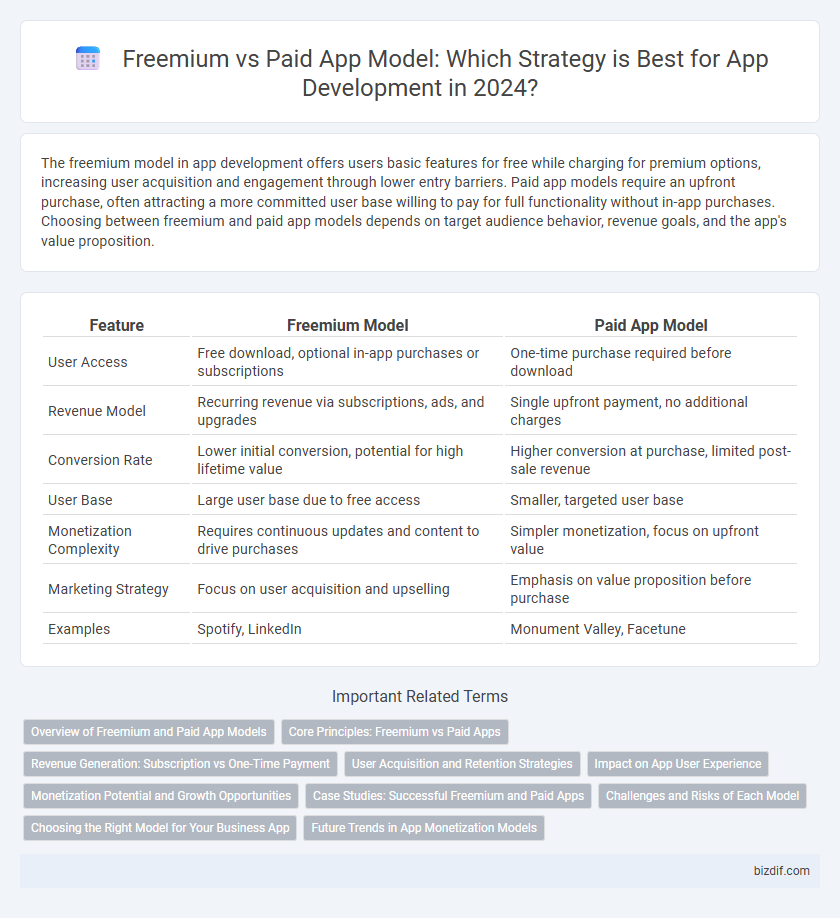The freemium model in app development offers users basic features for free while charging for premium options, increasing user acquisition and engagement through lower entry barriers. Paid app models require an upfront purchase, often attracting a more committed user base willing to pay for full functionality without in-app purchases. Choosing between freemium and paid app models depends on target audience behavior, revenue goals, and the app's value proposition.
Table of Comparison
| Feature | Freemium Model | Paid App Model |
|---|---|---|
| User Access | Free download, optional in-app purchases or subscriptions | One-time purchase required before download |
| Revenue Model | Recurring revenue via subscriptions, ads, and upgrades | Single upfront payment, no additional charges |
| Conversion Rate | Lower initial conversion, potential for high lifetime value | Higher conversion at purchase, limited post-sale revenue |
| User Base | Large user base due to free access | Smaller, targeted user base |
| Monetization Complexity | Requires continuous updates and content to drive purchases | Simpler monetization, focus on upfront value |
| Marketing Strategy | Focus on user acquisition and upselling | Emphasis on value proposition before purchase |
| Examples | Spotify, LinkedIn | Monument Valley, Facetune |
Overview of Freemium and Paid App Models
The Freemium model offers core app features for free while monetizing through in-app purchases or subscriptions, maximizing user acquisition and engagement. Paid app models require an upfront purchase, generating immediate revenue but potentially limiting initial downloads. Choosing between these models depends on target audience behavior, revenue goals, and long-term user retention strategies.
Core Principles: Freemium vs Paid Apps
Freemium apps operate on a model where the core functionality is free with optional in-app purchases or subscriptions unlocking premium features, driving user acquisition and retention through a low entry barrier. Paid apps require an upfront purchase before download, ensuring immediate revenue but potentially limiting the user base due to cost commitment. The freemium model emphasizes scalability and monetization through ongoing engagement, whereas paid apps prioritize initial revenue and clear product value from the outset.
Revenue Generation: Subscription vs One-Time Payment
The Freemium model drives revenue through subscriptions, generating consistent, recurring income and enabling continuous updates and premium features. In contrast, the Paid app model relies on one-time payments, providing immediate revenue but limited long-term earnings potential. Subscription-based apps tend to achieve higher lifetime value per user due to ongoing engagement and upselling opportunities.
User Acquisition and Retention Strategies
Freemium models leverage lower entry barriers to accelerate user acquisition by offering basic features for free while monetizing through premium upgrades, enhancing retention through continuous value delivery. Paid app models rely on upfront purchase commitment, attracting users with perceived quality and exclusivity, which can lead to higher initial retention among dedicated users. Effective retention strategies for freemium apps include in-app incentives and frequent updates, whereas paid apps focus on delivering superior user experience and ongoing support to sustain engagement.
Impact on App User Experience
The Freemium model enhances user experience by allowing access to basic features for free, encouraging trial and gradual feature discovery, which can lead to higher engagement and user retention. Paid app models deliver a seamless, ad-free experience upfront, fostering trust and satisfaction through immediate access to full functionality without limitations. User experience in Freemium apps may suffer from interruptions due to ads or restricted features, while Paid apps often provide consistent performance and premium support, influencing overall user perception and app loyalty.
Monetization Potential and Growth Opportunities
Freemium app models generate higher user acquisition rates by offering free access with optional in-app purchases, creating scalable revenue streams through subscriptions and microtransactions. Paid app models provide immediate revenue but often face limitations in user base expansion due to upfront cost barriers. Freemium models support greater long-term monetization potential and growth opportunities through continuous feature updates and targeted upselling strategies.
Case Studies: Successful Freemium and Paid Apps
Case studies reveal that apps like Spotify and Dropbox thrive under the freemium model by attracting millions of users with free features and converting a portion into paying subscribers, driving sustainable revenue growth. In contrast, paid apps such as Minecraft and Monument Valley demonstrate strong upfront revenue through one-time purchases while relying on exceptional user experience to justify their cost. Both models succeed by aligning monetization strategies with user expectations and market demands within the app development ecosystem.
Challenges and Risks of Each Model
Freemium app models face challenges including user retention difficulties and revenue dependency on in-app purchases, which may limit consistent cash flow and increase churn rates. Paid app models encounter risks related to lower initial user acquisition due to upfront costs and potential market resistance, impacting overall download volumes. Both models require strategic balance to optimize monetization while maintaining user engagement and satisfaction.
Choosing the Right Model for Your Business App
Selecting the right revenue model for your business app depends on user acquisition goals and monetization strategy. The Freemium model offers free basic features with paid upgrades, driving higher download rates and user engagement, ideal for apps needing rapid market penetration. Paid app models generate immediate revenue per download but may limit initial user base, suitable for niche apps with clear, immediate value.
Future Trends in App Monetization Models
Future trends in app monetization highlight a shift from traditional paid app models toward more hybrid freemium approaches that combine in-app purchases, subscriptions, and ad-supported content. The increasing integration of AI-driven personalization and blockchain-based microtransactions is expected to enhance user engagement and revenue streams. Developers are also exploring game-like reward systems and enhanced data analytics to optimize monetization strategies in evolving digital ecosystems.
Freemium model vs Paid app model Infographic

 bizdif.com
bizdif.com